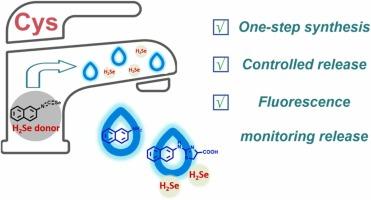荧光监测释放的可活化硒化氢供体一步合成及其在细胞中的应用
IF 3.7
1区 化学
Q1 CHEMISTRY, ANALYTICAL
引用次数: 0
摘要
硒作为生命必需元素,在含硒蛋白的合成、信号转导和氧化还原平衡的维持等方面发挥着重要作用。此外,硒化物因其抗癌作用而受到越来越多的关注。在人体内,硒化氢(H2Se)被认为是含硒分子生物转化的枢纽。因此,阐明H2Se的生理作用,也进一步促进了各种含硒化合物的生物应用,而这些都离不开H2Se供体的使用。然而,可控释放的H2Se供体非常有限,难以监测H2Se的释放。这不仅是限制H2Se研究的主要障碍,也表明制备优秀的H2Se给体是具有挑战性的。为此,我们设计并合成了一种一步合成的条件激活供体IN-D,能够通过荧光打开可视化H2Se释放。2-异氰酸萘酯与硒粉反应得到IN-D,在半胱氨酸触发下释放H2Se并发出荧光信号,实时监测H2Se的释放通量。据我们所知,这是第一个在生物环境中成功实现H2Se释放通量直接可视化的供体。我们相信,IN-D的开发不仅将为生物医学研究H2Se提供一个有前途的工具,而且还将为开发荧光生成H2Se供体提供灵感。本文章由计算机程序翻译,如有差异,请以英文原文为准。

One-step synthesis of an activatable hydrogen selenide donor with fluorescence-monitored release and its application in cells
As an essential element for life, selenium plays an important role in the synthesis of selenium-containing proteins, signal transduction and the maintenance of redox balance. In addition, selenides have received increasing attention for their demonstrated anticancer effects. In the human body, hydrogen selenide (H2Se) is considered to be a hub for the biotransformation of selenium-containing molecules. Therefore, elucidating the physiological roles of H2Se also further promotes the biological application of various selenium-containing compounds, all of which are inseparable from the use of H2Se donors. However, controlled-release H2Se donors are very limited and suffer from difficulties in monitoring H2Se release. This has not only been a major hindrance limiting H2Se research, but also indicates that the preparation of excellent H2Se donors is challenging. To this end, we have designed and synthesized a one-step synthetic, conditionally activated donor IN-D capable of visualizing H2Se release via fluorescence enhancement. IN-D was obtained by the reaction of 2-naphthyl isocyanide and selenium powder, which released H2Se and fluorescence signals upon triggering by cysteine, enabling real-time monitoring of the flux of H2Se release. To the best of our knowledge, this is the first donor that has successfully enabled direct visualization of H2Se release fluxes in a biological environment. We believe that the development of IN-D will not only provide a promising tool for biomedical research on H2Se, but also provide inspiration for the development of fluorescence-generating H2Se donors.
求助全文
通过发布文献求助,成功后即可免费获取论文全文。
去求助
来源期刊

Sensors and Actuators B: Chemical
工程技术-电化学
CiteScore
14.60
自引率
11.90%
发文量
1776
审稿时长
3.2 months
期刊介绍:
Sensors & Actuators, B: Chemical is an international journal focused on the research and development of chemical transducers. It covers chemical sensors and biosensors, chemical actuators, and analytical microsystems. The journal is interdisciplinary, aiming to publish original works showcasing substantial advancements beyond the current state of the art in these fields, with practical applicability to solving meaningful analytical problems. Review articles are accepted by invitation from an Editor of the journal.
 求助内容:
求助内容: 应助结果提醒方式:
应助结果提醒方式:


